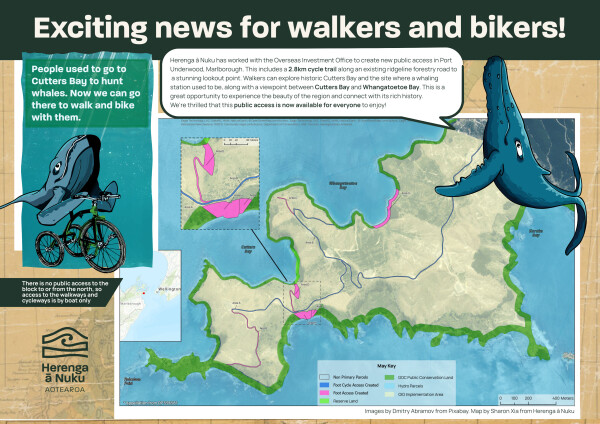Filter by Date:
Regional field advisors
Contact an advisor to investigate or negotiate public outdoor access.
Pocket Maps
Get the app to take our maps with you just about anywhere.
New walkways and cycleways in historic Cutters Bay
Posted under: Access, Tracks and trails
Published 26 April 2024
In March this year, Herenga ā Nuku Aotearoa, the Outdoor Access Commission, advised the Overseas Investment Office of new walkways and cycleways in Cutters Bay. This marks a significant milestone for community members and descendants of the original whalers, who have been eager for legal access to the area. Creating public access is part of the consent conditions relating to the purchase of the land by an overseas investor.
The 206-hectare land at Te Whanganui/Port Underwood, Marlborough, was purchased by Huimei Investment (NZ) Pty Limited, a forestry company, in 2018. Pine forest covers most of the land, but it also contains significant historical and scenic sites, including the site of a historic whaling station. As part of the purchase, Huimei agreed to protect the historic nature of the land and provide walking and cycling access to the significant viewpoints.
The newly created public access includes cycle access along the existing ridgeline forestry road. Cyclists and walkers get here by boat access to southern Whangatoetoe Bay then climb to the existing ridgeline forestry road which extends to a stunning headland lookout point to the south.
Walkers have the additional options of arriving in historic Cutters Bay, the site of an onshore whaling station in the early days, and walking to the end of Robertson Point at the tip of the headland or to a fantastic viewpoint between Cutters Bay and Whangatoetoe Bay, or along the foreshore in Whangatoetoe Bay which combines existing Sounds Foreshore Reserve with the newly created foreshore access.
There is no public access to the block to or from the north, so access to the walkways and cycleways is by boat only and stops at the property boundary.
The flat land in this bay is an archaeological site because it contains significant remains of early Māori occupation and the site of a nineteenth-century whaling station and settlement. Visitors need to respect the site's archaeological significance.
In the mid-19th century, Cutters Bay was home to well-known Port Underwood resident Sarah Dougherty and her husband, Captain Daniel Dougherty, who ran the whaling station and a grog shop. It is reported that Te Rauparaha and Colonel William Wakefield were regular visitors to the station — stopping for a drink of rum during their travels.
In 1848, the schooner Bee landed the South Island's first merino sheep in the adjacent bay, Whangatoetoe. The sheep, imported from Australia, became the foundation of the Marlborough flock.
In the 1940s, the remains of the sailing vessels Holmwood and Alameda were brought to Cutters Bay and scuttled. The remains are still visible in the water just off-shore.
The new access to Cutters Bay provides a unique opportunity for locals and tourists to explore the area's rich history and scenic beauty. The community members and descendants of the original whalers will be thrilled to see the area open up for future generations to enjoy.
Page last updated: 17 May 2024


